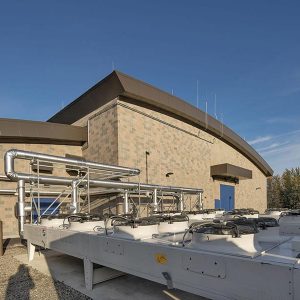F-35 Simulator
This project was a task-order-based design of a six-bay flight simulator facility, and RESPEC was responsible for the design of the electrical and mechanical systems. Because of the highly sensitive nature of the flight simulators and associated equipment, most of the building was designed as a Special Access Program Facility (SAPF). RESPEC provided energy modeling and mechanical, electrical, and communications engineering. Our services included a planning charrette, conceptual layouts, and an independent technical and compliance review.
MECHANICAL: The mechanical systems included heat-recovery ventilation units with dedicated outside air for increased energy efficiency. Multiple fan coil units provided the cooling air and humidity control required for the SAPF. Each fan coil had a two-by-two fan wall array to provide increased redundancy and variability of the system while ensuring maximum energy savings. Underfloor air distribution and displacement ventilation diffusers were used to provide effective cooling to the occupied spaces while allowing for energy-saving stratification in the high-bay spaces of the simulators.
• Heating: District steam from the base power plant supplied all of the heating needs of the building by using a steam-to-glycol heat exchanger. High-efficiency, finned tube radiation was located throughout the perimeter of the facility with zones distributed for individualized occupant control and comfort. To meet the cooling demand of the flight simulators and associated equipment, a centralized water-cooled chiller with free-cooling capacity was used. During the winter months, the chilled-water system uses an exterior air-glycol heat exchanger to provide all of the cooling for the building without operating the chiller, which results in significant energy savings.
• Plumbing: The plumbing systems for this facility included a water-treatment plant for the humidification units in the SAPF. This treatment used dechlorinator, water softener, and reverse-osmosis units to provide near-maintenance-free humidification to the sensitive equipment in the SAPF.
All of the mechanical equipment that served the SAPF was required to be fully redundant to ensure continued operations of the flight simulators.
ELECTRICAL:
• Power: Existing overhead power lines ran along the western side of the project site. The power service was tapped off of these lines and extended underground to a new pad-mounted transformer near the building. The main electrical room was on the unsecured side of the building but served both the unsecured and SAPF portions of the building. Interior power distribution kept the circuits on one side of the SAPF wall. The device types and quantities were provided per the functional requirements document and as required by code.
• Lightning Protection: A lightning-protection system was provided at this building to reduce the chance of damage from lightning strikes and protect the equipment.
• Lighting: Exterior lighting was sourced by LED to optimize energy efficiency and reduce long-term maintenance costs. Exterior lighting was photocell and direct digital control controlled through a lighting contactor. Interior lighting also used LED. Almost all of the spaces had occupancy-sensor controls to reduce energy use, except for areas regulated by code (e.g., electrical rooms) and in spaces that needed lights to remain off during use (e.g., simulator bays).
PROJECT CHALLENGES: The key challenges in this project included maintaining critical plant operations, meeting strict environmental requirements, maintaining high-security boundaries while accommodating maintenance, and keeping a limited building footprint. A detailed concept design was developed to confirm the feasibility and facilitate discussions of detailed requirements with users. Phased delivery of the process equipment required additional efforts to meet the environmental conditions while maintaining optimal energy efficiency.





Stay in Touch